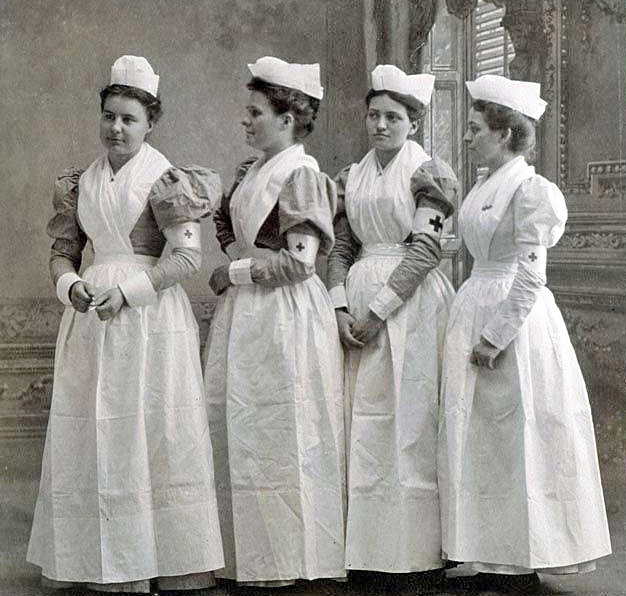8.1 Chapter Overview and Learning Objectives
In 2019, nurse Jessica Anderson completed the London Marathon wearing her work scrubs. She hoped to win an entry in the Guinness Book of World Records as the fastest person in a nurse’s uniform running a marathon. While she did run the fastest time, she was denied the award because her nurse’s uniform did not meet standards. The pictures in figure 8.1 show changes in nursing uniforms historically and today. According to the record officials, “the nurse’s uniform must include: a blue or white nurse dress, a white pinafore apron, a traditional white nurse’s cap. Tights are optional” (Burns 2019).
Anderson, and many others, disagreed that modern nurses should be held to an old-fashioned standard. The incident spread throughout the news and social media, with nurses posting pictures wearing their typical scrubs. A week later, the Guinness organization apologized and awarded Anderson the title. The Guinness organization also publicly acknowledged the need to address equity and inclusion in its rules. They changed their requirements due to the awareness raised by nurse Anderson and other health professionals. This example shows how gendered work norms can be found throughout society today.
In this chapter, we will discover how gender norms influence the workplace. Workplace rules and regulations guide gendered stereotypes and expectations, such as formal guidelines on what you should look like at work. We will also learn about workplace violence and the sex work industry.


Figure 8.1. Nurse uniforms from 1898 (on left) compared with a nurse’s scrubs today (on right).
8.1.1 Learning Objectives
After reading this chapter, you will be able to:
- Summarize the process of gender socialization inside the workplace.
- Explain barriers to the advancement of women, nonbinary, and trans people in the workplace.
- Examine the experiences of sex workers and victims of sex trafficking.
- Relate work inside the home to gender roles and expectations.
- Examine three forms of violence commonly experienced by people in their workplaces.
- Outline three interventions for social change in workplaces through Diversity, Equity, and Inclusion (DEI) programs, economic policy, and conceptions of labor.
8.1.2 Preview of Key Terms
You will need some of these key terms to connect to ideas in this chapter and throughout this textbook. You can find the full list of key terms at the end of this chapter. This list is not exhaustive, but it begins a deeper understanding of the concepts of gender in the workplace.
- gender pay gap: pay inequity across genders.
- glass ceiling: an artificial, unseen, and often unacknowledged discriminatory barrier that prevents otherwise qualified people such as women and minorities from rising to positions of leadership and power, particularly within a corporation.
- harassment: unwelcome conduct based on any number of demographic variables.
- human trafficking: “a crime that involves exploiting a person for labor, services, or commercial sex” (DOJ N.d.).
- second shift: household duties that follow a paid work day, typically completed by women.
- sex work: contact of a sexual nature in exchange for something else, such as money, property, and even means of survival such as food or safety.
8.1.3 Licenses and Attributions for Chapter Overview and Learning Objectives
Glass ceiling definition is from the Open Education Sociology Dictionary edited by Kenton Bell, which is licensed under CC BY-SA 4.0.
Figure 8.1. Photos of nurses’ uniforms are from American Red Cross nurses in Tampa, 1898, Wikimedia Commons, which is in the Public Domain and Woman in Medical Frontliner Uniform by Laura James, which is licensed under the Pexels License.
“Chapter Overview” by Jane Forbes is licensed under CC BY 4.0.

